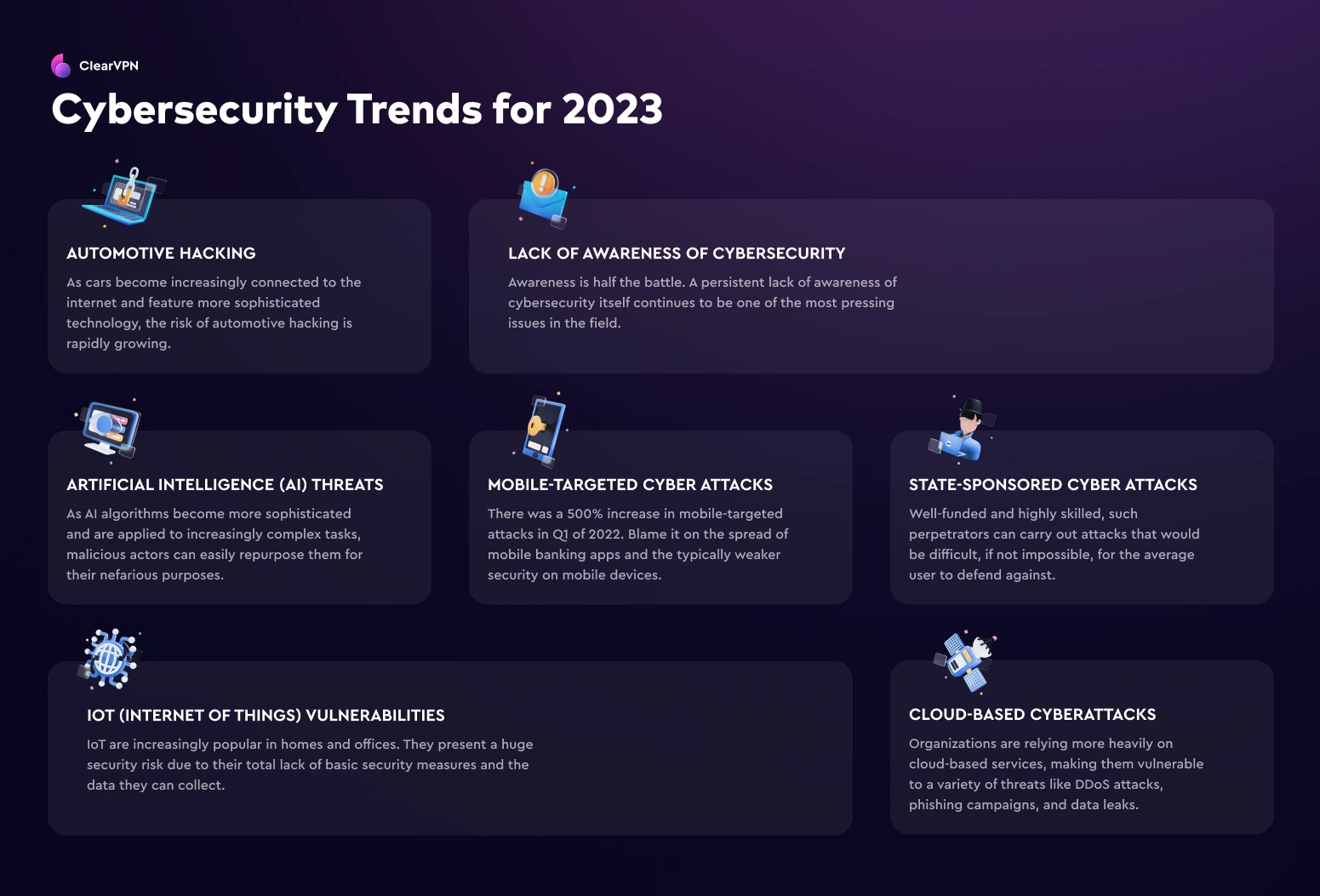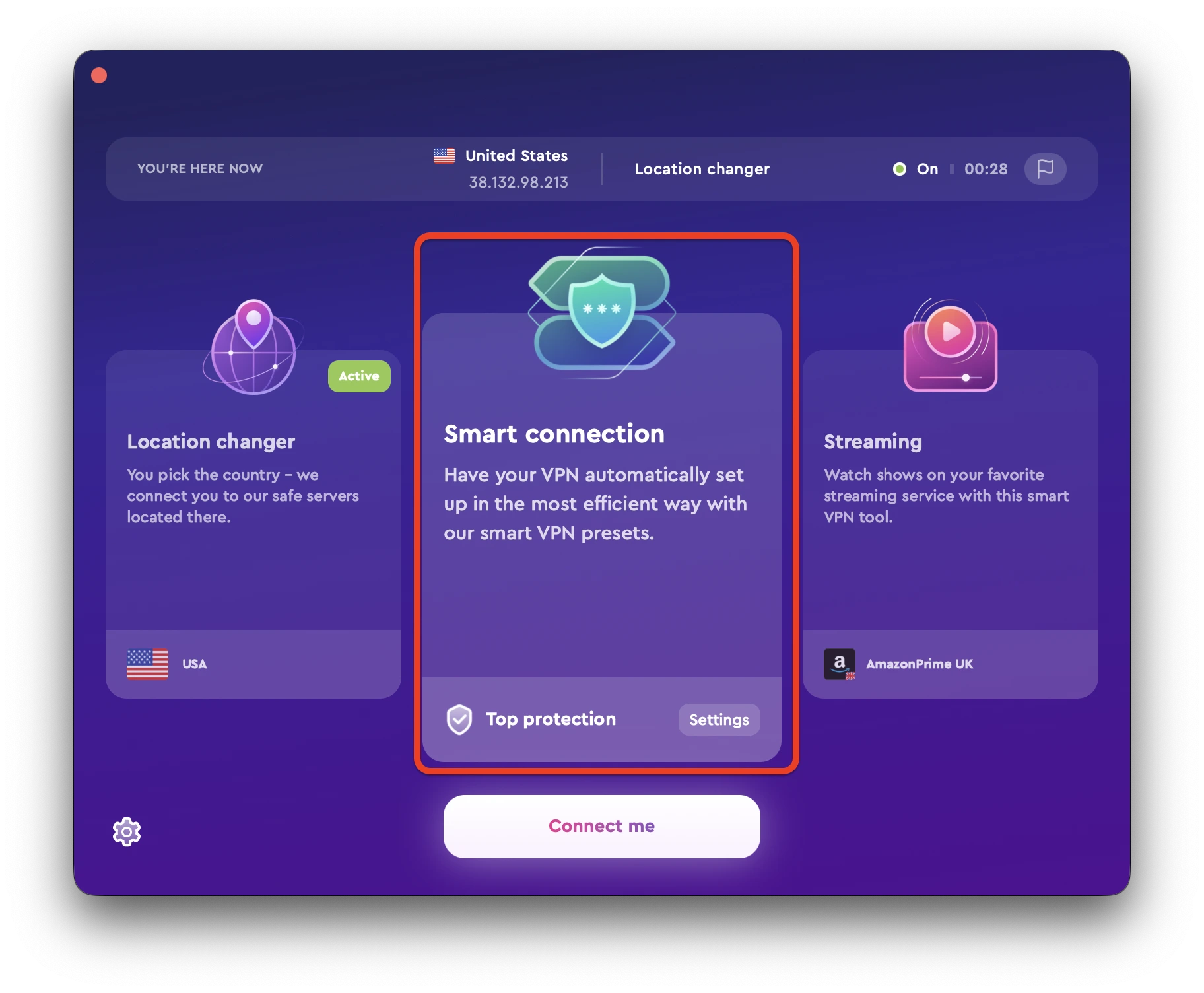As digital technology continues to evolve, so too do the cyber threats that come with it. To keep your identity and your data safe from exploitation, staying aware of the latest trends in cybersecurity is more important than ever. Knowing what to watch for and how best to protect yourself can save you a lot of headaches in the long run.
That’s where this article comes in. We pulled together some key insights and predictions to help you stay secure from the many malicious threats in the digital world. Read on and learn everything you need to know to keep you and your organization or business safe.
Cybersecurity Trends for 2023
1. State-sponsored cyber attacks
As the world continues to become more interconnected, governments increasingly leverage once-innocent digital technologies as tools for espionage and warfare.
The result has been a rise in malicious state-sponsored cyber attacks, often targeting critical infrastructure or sensitive government data. Well-funded and highly skilled, such perpetrators can carry out attacks that would be difficult, if not impossible, for the average user to defend against.
To give you an idea of the scope of this threat, consider the recent state-sponsored cyber attack perpetrated by “Mustang Panda” in February 2022. This China-based threat actor weaponized official-looking emails on geo-political subjects to carry out cyber espionage against target organizations in Europe, the US, and East Asia.
This is just one example of the advanced attacks that state-sponsored actors are capable of — and there will surely be more to come in 2023. Security experts warn that governments and organizations need to do more to protect themselves.
How to start, you ask? Well, one low-hanging fruit would be a strong cybersecurity strategy and policy. Governments need to ensure that their systems are up-to-date, patched regularly, and monitored for suspicious activity. This will make it more difficult for attackers to penetrate their systems.
2. Automotive hacking
Automotive hacking is one of the lesser-known trends in cybersecurity, yet it poses a direct threat to people’s lives and property. As cars become increasingly connected to the internet and feature more sophisticated technology, the risk of automotive hacking is rapidly growing.
Now while most people think of this cybersecurity trend as science fiction, the truth is that it has already happened:
- In 2015, two researchers successfully hacked into a Jeep Cherokee while driving it. This prompted the recall of over 1.4 million vehicles, underscoring the need for increased security in the automotive industry.
- In 2016, researchers discovered a vulnerability in the Tesla Model S that allowed hackers to remotely access and control the car’s systems from their computers.
2022 was a significant year for automotive cybersecurity, as the NHTSA (National Highway Traffic Safety Administration) released a set of guidelines for car manufacturers to help reduce the risk of cyberattacks — Cybersecurity Best Practices for the Safety of Modern Vehicles.
3. Cloud-based cyberattacks
Cloud technology has been a blessing and a curse in the world of cybersecurity. On the one hand, cloud-based services can help organizations increase their security by centralizing data, thereby reducing the risk of breaches. On the other hand, this same centralization provides cybercriminals with a larger attack surface to exploit.
According to a report from Continuity Central (a publication on enterprise risk management), cloud-based cyberattacks increased by 48% in 2022. This is because many organizations are now relying more heavily on cloud-based services, making them vulnerable to a variety of threats like DDoS attacks, phishing campaigns, and data leaks.
For 2023, cloud security will continue to expand as a primary focus for organizations and governments. The increased adoption of cloud services will drive the demand for better security measures. These measures include increasingly robust authentication protocols, new encryption methods, and improved threat detection systems.
4. Persistent lack of awareness of cybersecurity
An old saying can be applied to digital security — Awareness is half the battle. A persistent lack of awareness of cybersecurity itself continues to be one of the most pressing issues in the field.
According to a 2020 report published by World Economic Forum (a global non-profit organization), 95% of cybersecurity breaches are due to human error or negligence.
Fortunately, 2022 saw a shift in this narrative as organizations worldwide began investing more heavily in cybersecurity training and awareness programs. We fully expect this trend to continue in 2023, as much work remains to be done.
5. Artificial Intelligence (AI)
AI is one of the most exciting digital technologies of the 21st century. Unsurprisingly, it also poses a significant risk to data security and privacy.
As AI algorithms become more sophisticated and are applied to increasingly complex tasks, malicious actors can easily repurpose them for their nefarious purposes. A good example is the emergence of AI-based “deep fakes,” or fake videos in which any person can be made to say anything the creator wants. These use advanced visual and audio algorithms to create convincing videos that can be used to spread false or malicious information.
In 2022, a deep fake video went viral as it appeared to show Facebook founder Mark Zuckerberg discussing a plan to control the world’s population. Unsurprisingly, the video caused widespread confusion and panic before being debunked as a proof-of-concept project by a start-up company called Canny AI.
While it turned out to be a harmless jab to raise awareness about the potential misuse of AI, the video was an undeniable example of how this technology may be weaponized.
In 2023, it will become increasingly crucial to recognize and mitigate the potential risks AI poses. We would recommend increased scrutiny of and caution towards AI-based products and services. Whenever possible, strengthen your security measures such as authentication protocols. Additionally, organizations should invest in detection systems that can identify malicious activity related to AI-based systems.
6. Mobile devices: a favorite target for cybercriminals
Mobile devices have brought many conveniences to our lives that, even a few decades ago, no one would have thought possible. Nowadays, people can instantly access their data and connect with family and friends practically anywhere.
However, as with any popular technology, mobile devices have become a prime target for cybercriminals. According to cybersecurity researchers, there was a 500% increase in mobile-targeted cyber attacks in Q1 of 2022. Many data security experts claim that this is due to the increasing popularity of mobile banking apps, as well as the typically weaker security present on mobile devices.
Regardless of the cause, it’s evident that people need to do more to ensure that their mobile devices and apps are secure. It’s not as difficult as you might think and can be as simple as:
- Enabling two-factor authentication or multi-factor authentication
- Keeping apps up to date
- Using strong passwords and pin codes (no 123456!)
- Using a mobile security suite to protect against malware and data theft
And if you are keen on taking your mobile cybersecurity further, then you would want to consider investing in a good VPN (Virtual Private Network) service for your device. VPNs encrypt all data on your mobile device so that even if it is stolen or hacked, the data remains secure.
You can totally do that with ClearVPN! In just a few simple steps, you can protect your device from malicious actors and keep your data safe. Just install and run the ClearVPN app on your smartphone/PC, choose “Smart Connection” mode, and tap on the “Connect me” button.
That’s it — your device is now connected to a secure, encrypted VPN connection. At that point, you’d be already doing more than most people to protect yourself from mobile cyber attacks!
7. IoT: the weakest link in Cybersecurity
Ever notice how many “smart” devices are pouring into the market nowadays? This could include everything from smart speakers to connected cameras, thermostats, and even refrigerators.
Collectively, these devices are classified as IoT (Internet of Things) and are increasingly popular in our homes and offices. However, they present a huge security risk due to their total lack of basic security measures and the sheer amount of data they can collect.
According to an ongoing study by Statista (a market research firm), the number of connected IoT devices worldwide will reach more than 15 billion by the end of 2023. This presents a huge security risk, and everyone needs to start taking the necessary steps to protect themselves from malicious actors looking to weaponize these devices.
For consumers, this means changing the default passwords on their devices, keeping them updated with the latest security patches and software, and being cautious when downloading apps or connecting to public Wi-Fi networks.
Organizations need to be just as diligent, if not more so, in protecting their IoT devices. They should have policies in place for managing these devices, ensuring they are kept secure at all times. Additionally, organizations should consider investing in solutions such as network segmentation and anomaly detection to help prevent malicious actors from gaining access to their IoT network.
Conclusion
Cybersecurity in 2023 is shaping up to be an uphill battle due to the endless emergence of new cyber threats and the ever-increasing sophistication of existing ones. Deep fakes and other scams will likely become more prevalent as AI technology evolves.
Given these challenges, it’s up to us — organizations, governments, businesses, and individuals, to do what we can and stay one step ahead. Whether it’s by following best practices for data security or investing in robust cybersecurity solutions, we can all do our part to make the digital landscape safer for 2023 and beyond.
FAQs
What is the #1 cybersecurity threat today?
Cybersecurity professionals are raising alarms about the increasing risk of cyberwarfare and state-sponsored attacks. We rank it as the single greatest threat to consider, given the latest cybersecurity trends.
Think about it — given the sheer size of the organizations behind these threat actors and the resources at their disposal, they could access and exploit all the latest technologies and leverage them to serve a malicious agenda. As a result, the damage inflicted by these threats could be catastrophic.
What is the next big thing in cyber security?
Blockchain technology is a rapidly emerging field of study with potential applications in cybersecurity. It offers a decentralized way to store and share data securely, helping to protect against data tampering and other malicious activities.
How to make IoT devices secure?
The problem with IoT devices is that they often don’t have any built-in security features, which can be easily compromised by malicious actors. Still, there is one thing that you can do to make sure your IoT devices are secure regardless of their security features (or lack thereof) — run them off a VPN network.
A VPN provides an encrypted connection to a secure server, making it much harder for malicious actors to gain anything useful from a compromised IoT device. Don’t forget to follow the basic precautions, such as choosing strong passwords and keeping all of your devices up-to-date with the latest security patches and software.
